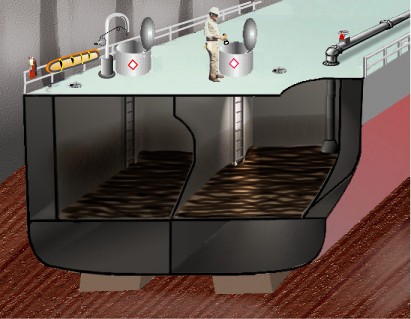Shipyard Employment eTool
Cleaning and Other Cold Work » Cleaning Preparation
Before you perform cold work, prepare spaces for entry and work by:
A Shipyard Competent Person (SCP) must then conduct atmospheric testing and a visual inspection of the space. [See Confined or Enclosed Spaces and Other Dangerous Atmospheres]
Following the pre-entry inspection, shipyard personnel must:
Preparation for cleaning and cold work also includes coordinating the necessary personnel, equipment, and materials required for Cleaning and Cold Work Operations.

The vessel's crew off-loads the cargo, washes the spaces through the butterworth openings, and pumps out the space, where appropriate. However, residues often remain in the space when the vessel reaches the shipyard.
Potential Hazard
- Residues may be toxic (e.g., styrene, urea), corrosive (e.g., caustic soda, pencil pitch), or flammable/combustible (e.g., crude oil, gasoline). These residues can cause illness, fire, or explosion.
Requirements and Example Solutions
- Liquid residues of hazardous materials must be removed from work spaces as thoroughly as possible before employees begin cleaning operations. [29 CFR 1915.13(b)(1)]
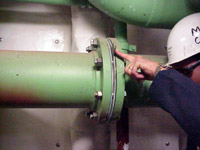
Potential Hazard
Pipes and pumping systems that enter the space may contain residual liquid, flammable or combustible gases or vapor and toxic, corrosive, or irritant materials. These materials may be released or inadvertently pumped into the space, exposing workers to safety and health hazards.
Requirements and Example Solutions
- Pipes and pumping systems entering the work space must be disconnected, blanked off, and/or secured by a positive method, if they are possibly carrying hazardous materials. [29 CFR 1915.15(a)]
- Pumps within the system must be secured (e.g., disabled). [29 CFR 1915.15(a)]
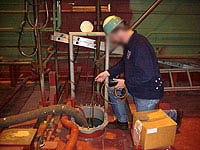
Potential Hazards
- Workers entering a space containing flammable, combustible, toxic, corrosive or irritant vapors, mists, or gases are at risk of fire and explosion, as well as health hazards.
- Cleaning operations may also generate concentrations of flammable, combustible, toxic, corrosive or irritant vapors, mists, or gases through interaction of cleaning agents, or reactions of cleaning agents with residues.
Requirements and Example Solutions
- Testing must be conducted by a Shipyard Competent Person (SCP) to determine the concentration of flammable, combustible, toxic, corrosive, or irritant vapors within the space.[29 CFR 1915.13(b)(2)]
- Continuous ventilation must be provided at volumes and flow rates sufficient to ensure that the concentrations of:
- Flammable vapor is maintained below 10% of the lower explosive limit. [29 CFR 1915.13(b)(3)(i)]
- Toxic, corrosive, or irritant vapors are maintained within the permissible exposure limits and below IDLH. [29 CFR 1915.13(b)(3)(ii)]
- When ship repair operations result in flammable/combustible atmospheres:
- All air-moving equipment and its component parts, including duct work capable of generating a static electric discharge of sufficient energy to create a source of ignition; must be electrically bonded to the structure of a vessel or vessel section, or in the case of landside spaces, grounded to prevent an electric discharge in the space. [29 CFR 1915.13(b)(11)]
- Fans must have non-sparking blades and portable air ducts shall be of non-sparking materials. [29 CFR 1915.13(b)(12)]

Potential Hazard
Without warnings, workers may enter unsafe spaces and be exposed to safety and health hazards.
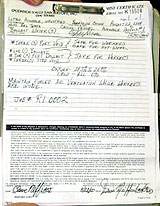
Requirements and Example Solutions
- The (warning) signs posted shall be presented in a manner that can be perceived and understood by all employees. [29 CFR 1915.16(a)]
- If the space contains an oxygen-deficient or -enriched atmospheres, the space must be labeled "Not Safe for Workers" and not entered until the oxygen content is between 19.5% and 22%. [29 CFR 1915.12(a)(2)]
- If the concentration of flammable vapors or gases in the space is equal to or greater than 10 percent of the lower explosive limit the space must be labeled "Not Safe for Workers" and not entered until the concentration of flammable vapors is maintained below 10% of the LEL. [29 CFR 1915.12(b)(2)]
- If the space contains an air concentration of a material which exceeds a Part 1915 Subpart Z permissible exposure limit (PEL) or is IDLH, the space shall be labeled "Not Safe for Workers." [29 CFR 1915.12(c)(2)]
- The shipyard competent person report and/or Marine Chemist certificate must be posted in the immediate vicinity of the effected operation while work is in progress. [29 CFR 1915.7(d)(2) and 29 CFR 1915.14(a)(2)]
- Signs prohibiting sources of ignition within or near spaces that previously contained flammable or combustible liquids or gases must be posted at the entrance to those spaces, in adjacent spaces, and in the open area adjacent to those spaces. [29 CFR 1915.13(b)(10)]
- A warning sign or label may be posted at the means of access if the entire work area has been tested. [29 CFR 1915.16(b)]
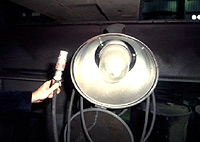
Potential Hazards
- Workers entering spaces containing flammable or combustible vapors and gases are at risk of fire and explosion if the space also contains improper electrical equipment.
- Inadequate illumination in a space can lead to injuries from slips, trips, and falls.
- Workers entering inadequately illuminated spaces may become disoriented and fail to find the exit. This prevents the worker from safely exiting the space.
- Inadequate illumination can prevent workers from safely performing tasks.
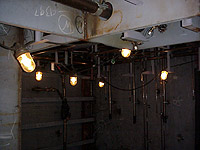
Requirements and Example Solutions
- Only explosion proof, self-contained portable lamps (e.g. explosion-proof flashlight) or other electric equipment approved for hazardous locations by a National Recognized Testing Laboratory (NRTL), shall be used until the space is deemed "Safe for Workers". [29 CFR 1915.13(b)(9)]
- All means of access and walkways leading to work areas as well as working areas themselves must be adequately illuminated. [29 CFR 1915.82(a)(1)]
- Temporary lights must meet the requirements of 29 CFR 1915.82(b) and (c).
- Where temporary lighting from sources outside the vessel is the only means of illumination, portable emergency lighting equipment must be available to provide illumination for safe movement of employees. [29 CFR 1915.82(c)(2)]
- Employees must not be permitted to enter dark spaces without a suitable portable or emergency light. [29 CFR 1915.82(c)(1)]
- The use of matches and open flame lights is prohibited.[29 CFR 1915.82(a)(5)]
- Explosion-proof, self-contained temporary or portable lights are required in any area that the atmosphere is determined to contain a concentration of flammable vapors that are at or above 10 percent of the lower explosive limit (LEL) (29 CFR 1915, subparts B and C) (29 CFR 1915.82(d))
- All illumination equipment must meet the requirements of 29 CFR 1915.82.
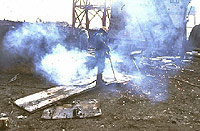
Potential Hazard
- Toxic, corrosive, irritant, or high pressure/temperature cleaning agents and their application equipment, may put the safety and health of workers at risk.
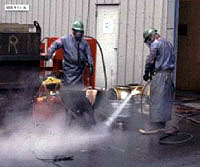
Requirements and Example Solutions
- A hazard assessment must be made to determine the appropriate PPE. [29 CFR 1915.152(b)]
- Also see the PPE requirements for specific cleaning operation hazards that may be encountered:
Additional Resources
- See the Ship Repair: PPE module for information on general PPE requirements and example specific cleaning operation PPE.


